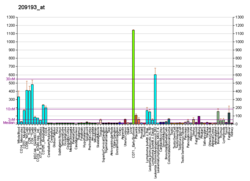Proto-oncogene serine/threonine-protein kinase Pim-1 is an enzyme that in humans is encoded by the PIM1 gene.[5][6][7]
Pim-1 is a proto-oncogene which encodes for the serine/threonine kinase of the same name. The pim-1 oncogene was first described in relation to murine T-cell lymphomas, as it was the locus most frequently activated by the Moloney murine leukemia virus.[8] Subsequently, the oncogene has been implicated in multiple human cancers, including prostate cancer, acute myeloid leukemia and other hematopoietic malignancies.[9] Primarily expressed in spleen, thymus, bone marrow, prostate, oral epithelial, hippocampus and fetal liver cells, Pim-1 has also been found to be highly expressed in cell cultures isolated from human tumors.[8] Pim-1 is mainly involved in cell cycle progression, apoptosis and transcriptional activation, as well as more general signal transduction pathways.[8] Pim-1's role in oncogenic signalling has led to it becoming a widely studied target in cancer research, with numerous drug candidates under investigation which target it.[10][11]
- ^ a b c GRCh38: Ensembl release 89: ENSG00000137193 – Ensembl, May 2017
- ^ a b c GRCm38: Ensembl release 89: ENSMUSG00000024014 – Ensembl, May 2017
- ^ "Human PubMed Reference:". National Center for Biotechnology Information, U.S. National Library of Medicine.
- ^ "Mouse PubMed Reference:". National Center for Biotechnology Information, U.S. National Library of Medicine.
- ^ "Entrez Gene: PIM1 pim-1 oncogene".
- ^ Domen J, Von Lindern M, Hermans A, et al. (June 1987). "Comparison of the human and mouse PIM-1 cDNAs: nucleotide sequence and immunological identification of the in vitro synthesized PIM-1 protein". Oncogene Research. 1 (1): 103–12. PMID 3329709.
- ^ Meeker TC, Nagarajan L, ar-Rushdi A, et al. (June 1987). "Characterization of the human PIM-1 gene: a putative proto-oncogene coding for a tissue specific member of the protein kinase family". Oncogene Research. 1 (1): 87–101. PMID 3329711.
- ^ a b c Bachmann M, Möröy T (April 2005). "The serine/threonine kinase Pim-1". The International Journal of Biochemistry & Cell Biology. 37 (4): 726–30. doi:10.1016/j.biocel.2004.11.005. PMID 15694833.
- ^ "Pim-1 Oncogene". Retrieved 2015-12-14.
- ^ Luszczak S, Kumar C, Sathyadevan VK, et al. (2020). "PIM kinase inhibition: co-targeted therapeutic approaches in prostate cancer". Signal Transduction and Targeted Therapy. 5: 7. doi:10.1038/s41392-020-0109-y. PMC 6992635. PMID 32025342.
- ^ Malone T, Schäfer L, Simon N, et al. (March 2020). "Current perspectives on targeting PIM kinases to overcome mechanisms of drug resistance and immune evasion in cancer" (PDF). Pharmacology & Therapeutics. 207: 107454. doi:10.1016/j.pharmthera.2019.107454. PMID 31836451. S2CID 209357486.





